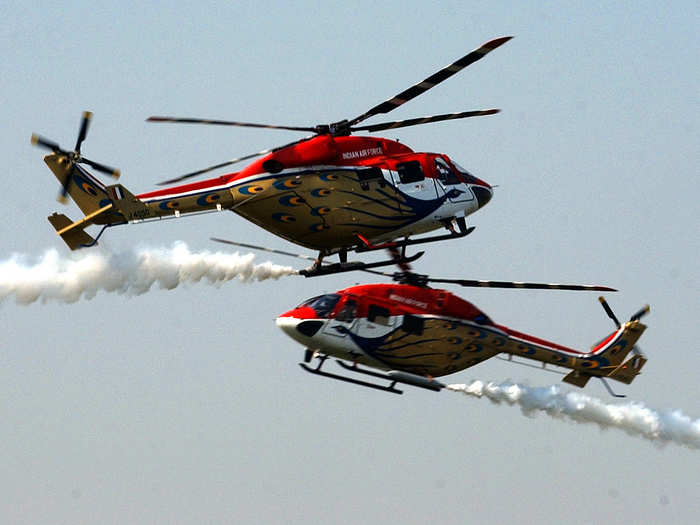
Mission Shakti, India's anti-satellite weapon designed by the Defence Research and Development Organisation (DRDO)BCCL

These three choppers are developed by HAL in cooperation with Taneja Aerospace and Aviation Limited (TAAL) indigenously within India.

The AH-64E Apache attack helicopter and the Chinook heavy-lift helicopter are manufactured by the US-based defence mammoth Boeing. The MH-60 Seahawk maritime helicopters are produced in the US by Sikorsky Aircraft.
In comparison to the fully-equipped Apache and Chinook, Rudra and LCH are “essentially unarmed”. Analysis shows that Rudra and LCH have no precision strike or anti-air capability, even though both these features were planned from the get-go.
Cochin Shipyard and Millennium Aero Dynamics indigenously developed and produced the INS Vikrant and they’re currently working on INS Vishal, which is currently in the design stage.
The Admiral Grigorovich-class stealth frigates were imported from the Yantar Shipyard in Russia. Something, the government planned to acquire more of going forward.

The Tejas fighter aircraft is manufactured in India by HAL and TAAL. The Sukhoi 30 MKI, though also produced by HAL and TAAL, was developed by the Sukhoi Design Bureau in Russia.
Since the import of the Tejas aircraft will be banned after December, the Air Force plans to buy another 123 for around ₹85,000 crore before the deadline hits.

The Rafale aircraft, five of which arrived in India late last month, is developed and manufactured by Dassault Aviation in France. The PC-7 light trainer aircraft is imported from Pilatus Aircraft in Switzerland and the Pipistrel Virus Garud ultralight utility aircraft from Pipistrel in Slovenia.

The Arjun Battle tank is developed by the Defence Research and Development Organisation (DRDO) and produced in the Heavy Vehicles Factory in Avadi.
The Bhishma T-90, though currently developed and manufactured by Russia in Uralvagonzavod, may shift assembly to Avadi in the near future.
The catch with these tanks is that even though the trials team recommended air conditioning, the Army chose to induct T-90 Main Battle Tanks (MBTs) without it — which can make things messy during an Indian summer.

India imports around $2.7 million worth of defence equipment from Israel. This includes the Syder mobile air defence system as well as Heron and Searcher drones.
In fact, the Indian Air Force used some its Israeli equipment during its raid on the Balakot terrorist training camp in Pakistan last year — including the Heron drones, the Phalcon airborne early warning and control system, SPICE 200 and the Popeye precision-guided munitions.
India, so far, lacks the technological capability to create its own defence drones. However, the DRDO does have plans to develop and produce air-launched drones in collaboration with the Air Force Research Laboratory in the US. It is also working on its very own Nishant unmanned aerial vehicle.

An import ban doesn’t mean that India can’t collaborate with foreign countries in order to build up its own defence capabilities. For instance, India’s current research with Japan focuses on technology that can further boost the efficiency of unmanned ground vehicles and robotics.
With the US, India is focusing on lightweight small arms technology and air-launched drones.
At home, HAL and BEL have set up the Defence Innovation Organisation (DIO), which has a Defence Excellence (iDEX) programme. So far, there have been rounds of the programme, which have led to designs for unmanned ground and underwater vehicles, GPS anti-jam devices, and individual protection systems among other things.
 I tutor the children of some of Dubai's richest people. One of them paid me $3,000 to do his homework.
I tutor the children of some of Dubai's richest people. One of them paid me $3,000 to do his homework. John Jacob Astor IV was one of the richest men in the world when he died on the Titanic. Here's a look at his life.
John Jacob Astor IV was one of the richest men in the world when he died on the Titanic. Here's a look at his life. A 13-year-old girl helped unearth an ancient Roman town. She's finally getting credit for it over 90 years later.
A 13-year-old girl helped unearth an ancient Roman town. She's finally getting credit for it over 90 years later. Sell-off in Indian stocks continues for the third session
Sell-off in Indian stocks continues for the third session
 Samsung Galaxy M55 Review — The quintessential Samsung experience
Samsung Galaxy M55 Review — The quintessential Samsung experience
 The ageing of nasal tissues may explain why older people are more affected by COVID-19: research
The ageing of nasal tissues may explain why older people are more affected by COVID-19: research

Copyright © 2024. Times Internet Limited. All rights reserved.For reprint rights. Times Syndication Service.